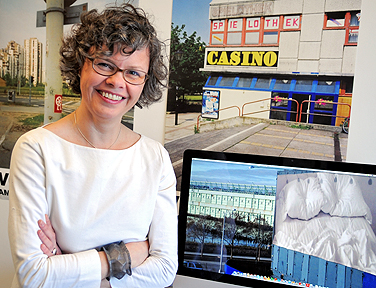Close Up
City view
From Berlin to Buffalo, Paeslack focuses on urban image

Miriam Paeslack has devoted most of her research to the different aspects of the relationship between the photographic image and urban space. Photo: NANCY J. PARISI
-
 Print
Print -
 Comments
Comments
-
“As a research and academic subject, we look at how and why the arts and culture in society matter, not only in America but internationally.”
When Miriam Paeslack was teaching in Leipzig in the former East Germany, she experienced a once-great city that had been on a post-industrial decline but was then on the verge of reconstruction after the Berlin Wall came down.
When she arrived in Buffalo in 2009 with her husband, Jordan Geiger, she saw a city with similarities. Geiger had accepted an appointment as assistant professor in UB’s School of Architecture and Planning.
“There was no positive rhetoric about Buffalo, only a nostalgia for the past, of the glorious time when enormous wealth shaped the city and beautiful architecture was built, prior to the downfall of the city in more recent years. There seemed to be nothing in between,” she says of her initial impression. “I became curious from the beginning as to what else was here.”
Paeslack, whose research interest is centered on urban imagery, set about to familiarize herself with Buffalo to find a new focus for her work. While serving as an adjunct professor in visual studies and arts management at UB, Paeslack organized a symposium titled “Ineffably Urban” at Hallwalls Contemporary Arts Center last spring in association with the Cultures and Texts strategic strength of the UB 2020 plan. The seminar brought together a diverse group of people to share how their contributions have helped define Buffalo. “It allowed us to talk about Buffalo beyond the clichés, beyond the city that used to be great but is not anymore.”
Last fall, Paeslack was named assistant professor in the Arts Management Program in UB’s College of Arts and Sciences. While ensconced in teaching museum management and academic research, she dug deeper into her focus on Buffalo by initiating the Urban Image Research Workshop, sponsored by UB’s Humanities Institute.
The workshop includes UB faculty from visual studies, architecture, media study, history, American studies and anthropology. The aim is to establish communication between the humanities and those at UB who are concerned with shaping and learning about the city. Faculty and graduate and PhD students present their work, the group discusses texts and guest speakers appear in the monthly sessions.
Paeslack says that the workshop group now is looking to develop a major conference or exhibition centered on a common goal, such as exploring different aspects of Buffalo and the image we make of it.
“Every member, for example, might think of a particular tour that is not necessarily following a typical urban route or based on the city’s historical monuments, but rather something that this member of the group thinks of as important for his or her urban experience. For example, I’m also a member of a faculty group that has been working with the Grant Street Neighborhood Center on Buffalo’s West Side, a group of diverse faculty from history, sociology, American studies and architecture that has been in dialogue with the center about programming, especially for underprivileged youth,” she explains.
Paeslack’s interest in urban issues and development began when she was growing up in Heidelberg in West Germany during the Cold War. “Part of my family is from East Berlin and so we would have to cross the border. It was very much an enforced border, with the Berlin Wall as its most threatening reminder,” she recalls. “I found it fascinating to see how West Berlin and East Berlin were such different cities. Even the smell was different.”
Trained in Germany, Italy and the U.S., she received her PhD in art history and the history of public and civil law from the University of Freiburg, Germany. She has dedicated most of her research to different aspects of the relationship between the photographic image and urban space. For the past 10 years, her primary research focus has been on Berlin. She is completing a book, “Imaging Berlin: Unification in Photographs (1871-1914),” which she expects to submit to the University of Minnesota Press in the fall.
“A lot of these images have never been published before, so that will be exciting. To my knowledge no one has made an attempt to publish any academic work on these photographs,” she says. “There’s been no scholarly attempt to look at how urban imagery in Berlin—the photography and the city—interrelate and how they’ve impacted each other.”
Paeslack has embraced her role in the budding Arts Management Program here. “As a research and academic subject, we look at how and why the arts and culture in society matter, not only in America but internationally. The program has been in place here for only six years, but our application numbers are increasing. This year, we have the highest number of Fulbright applications that we’ve ever had. We have a large amount of international students who come and who broaden our understanding of the importance culture has in a society.”
After nearly three years in Buffalo—Paeslack resides with her husband in the Elmwood district—she admits that her impressions have changed. “My feelings have not so much to do with the fact that the city has changed dramatically since I came here, but rather that I’m more involved with the city. That has a lot to do with people and with colleagues and with friends that I’ve been making since I’ve come here and that really brings life and blood to the city. I think there’s a very strong sense that the community is a very, very fruitful, productive and creative place. The more you get involved with a community, the more you feel at home.”

Reader Comments